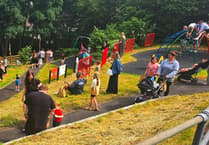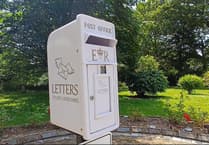Plans for a number of large ‘smart hub’ digital screens will be an “alien feature” in Cornwall’s capital city and will “generate harm” to the conservation area. That is the view of Historic England which is concerned about plans for the large, free-standing screens and the effects they may have on Truro’s conservation area and its historic listed buildings.
Planning permission and advertisement consent is sought by Urban Innovation Company (UIC) for the installation and operation of Pulse Smart Hubs at 13 locations in and around Truro. Two of the more sensitive locations – in Boscawen Street and Lemon Street – have already been removed from the application.
The proposal has been developed in collaboration with Truro City Council, Truro Business Improvement District (BID), Devon and Cornwall Police and the Truro Neighbourhood Police, Cornwall Council and the Community Safety Partnership. A planning statement says the scheme is “very strongly supported” by the Safer Cornwall Partnership which recognises that the hubs will deliver “a range of benefits for residents, businesses and visitors to Truro that support vibrant, safe, supportive communities, alongside enhancing digital infrastructure and supporting local economic development”.
Pulse Smart Hubs are free-standing structures featuring a fully accessible interactive tablet along with larger digital display screens on two sides. They are free to councils, the public and taxpayer. Their operator, UIC, pays for the installation, operation and ongoing maintenance of the hubs through paid-for advertising on the main screens.
The touchscreen provides the capability of free access to:
- Built-in public access defibrillator;
- Built-in nasal Naloxone opioid antagonist (a drug used under controlled conditions for the emergency treatment of a drug overdose);
- Emergency safety button to support anyone who is vulnerable;
- 999 emergency service button;
- Free phone calls with a built-in speaker and receiver;
- Free wi-fi;
- Digital wayfinding / mapping;
- Wireless mobile phone charging;
- ‘Hyper-local’ information on what’s on, council services and helplines.
Ten of the proposed hubs would be situated within Truro’s conservation area and are intended to replace and upgrade the existing black information boards in the city. Truro City Council has objected to the application on the grounds that it is not happy with more than half of the locations due to the impact on the historic environment.
The sites where the Pulse Smart Hubs could be placed are:
- Pavement outside public conveniences, Back Quay;
- Pavement outside Chiltern House, City Road;
- Pavement outside Volvo dealership, Threemilestone Industrial Estate;
- Pavement outside Penhaligon House, Green Street;
- Pavement outside Marks & Spencer, Lemon Quay;
- Verge outside Unit B1, Newquay Road Retail Park;
- Pavement outside Bridge House next to Old Bridge Street Car Park, St Clement Street;
- Pavement outside Treliske Retail Park, Penventinnie Lane;
- Pavement outside 90 Pydar Street;
- Pavement outside 22 and 22a River Street;
- Pavement outside Truro Railway Station, Station Road;
- Pavement outside Treyew Road Retail Park;
- Pavement outside 22 Victoria Square.
Truro Conservation Area Advisory Committee has also objected to the proposal. Members acknowledged the applicant’s reasons for introducing the screens in the city but believed that, in Truro, the hub units would be “intrusive, unwanted and unnecessary”.
Its report to Cornwall Council states: “It was considered that the deployment of ‘smart hub’ installations was far more suited to larger scale urban environments, where the scale of sizeable city centres, their buildings, street formats and planned urban spaces could readily accommodate the considerable form of the units without hindering pedestrian movement or dominating the streetscape. Although having cathedral city status, Truro is classified as a small town predominantly featuring correspondingly scaled buildings, streets and urban spaces. Even the illustrations submitted with the applications indicate how unacceptably overbearing the hubs will appear within that smaller scale context.”
In a letter to the council dated June 16, Historic England’s Inspector of Historic Buildings and Areas Catherine Marlow said: “In our opinion, in these locations [Victoria Square, River Street, Green Street and Back Quay] the hubs [will] generate harm to the parts of the conservation area and setting of listed buildings in which they lie. Their introduction into the historic environment will cause harm to the special interest of some listed buildings, where a part of that significance stems from their settings.
“The conservation area will also not be ‘preserved or enhanced’ by the proposals – its character and appearance will instead be harmed. The hubs are of considerable size, will have animated and lit advertising, and will be an alien feature in the Truro’s town centre in some of the locations proposed.”
Historic England recommends that some of the proposed hubs are removed and some moved in order to avoid or minimise the harm to Truro’s heritage assets. A proposal for 14 of the hubs in and around Newquay was approved by Cornwall Council earlier this month despite some local opposition.
For more details see application PA25/02295 on Cornwall Council’s planning portal.





Comments
This article has no comments yet. Be the first to leave a comment.